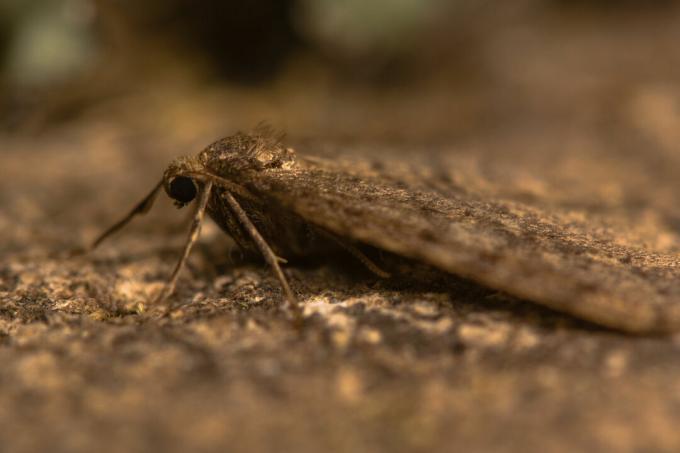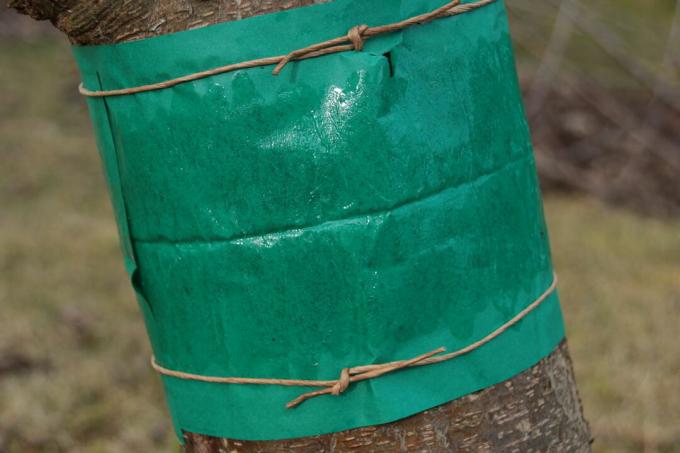You will find out what you can do preventively to keep the frost wrench away from trees and how you can recognize and fight it in the event of an infestation.

The frost wrench (Operophtera brumata) is polyphagous, which means that he likes to attack all kinds of trees. Deciduous trees, fruit trees, berry bushes and Roses are just as much on his menu as many ornamental shrubs. Fortunately, the insatiable caterpillars are easy to spot and control is relatively easy - if you know how to do it.
contents
- Recognize frost wrench
-
Prevent frost tension
- Promote beneficial organisms
- Glue rings
- Fight frost wrenches
The little frost wrench (Operophtera brumata) is a worldwide widespread butterfly that can cause great damage to deciduous trees. The adult moths hatch - presumably depending on the soil temperature - between mid-October and early November. The flightless females climb the trunk of the host tree and are mated by the winged males on the way to the crown. Eggs are preferably laid in close proximity to buds and around the onset of the first night frosts. A female can lay up to 300 eggs. When winter is over, the eggs hatch into the Spanner caterpillars, exactly at the time when the young buds break open, until the beginning of May. In the course of their caterpillar life, the tensioners eat buds, leaves, flowers and even young fruits. If they have developed sufficiently far, the caterpillars can be lowered to the ground on a caterpillar silk thread pupate in the ground - only to hatch in October as adult frostbite and the next generation to emerge witness.

So that your plants do not fall victim to the voracious tension caterpillars, you will find everything you need to know about recognizing, preventing and fighting the frostbite below.
Note on the great frost wrench: The Great Frost Wrench (Erannis defoliaria) occurs far less often in the home garden. Its biology is similar to that of the little frost moth, although it is not the same genus. The control measures are also the same as for the little frost wrench.
Recognize frost wrench
If you check the buds of your woody plants, you can find the half a millimeter large, red eggs of the frost moth in autumn. The caterpillars that hatch are initially only around one millimeter long and dark gray. In the course of their development they become two and a half centimeters tall and turn light green in color. The special type of locomotion of the caterpillars is easy to recognize: Because Spanner caterpillars only have one Having a single pair of rear abdominal legs, they make a very high one with every step "Humpback". In order to be able to feed undisturbed, the caterpillars like to spin themselves between the leaves of the host plant, which is where their German name comes from. If the infestation is very severe, the leaves can even become skeletonized, so that only the leaf framework remains. As a rule, however, the damage looks worse than it actually is. The Frostspanner caterpillar is very fond of eating the young fruits of sweet cherries on one side - also known as "spoon-fed". The caterpillars can be found between April and June. The finished moths show a clear sexual dimorphism - males and females therefore differ greatly from one another. While the males are gray-yellow to beige-brown in color and brown-yellow, fringed wings of a maximum of two and a half Centimeters wide, the females are brownish-gray and have only stunted stub wings in the same Colour. Both have short, hairy antennae and a useless proboscis - the moths do not eat any food and die after a few days.

Prevent frost tension
Anyone who has frequently observed damage from the frost winder in recent years should ask themselves one thing above all: Is the damage relevant? Especially for hobby gardeners, for whom high yields are not a must, a regular, weak infestation can often be tolerated and is hardly worth the effort of fighting.
Promote beneficial organisms
In near-natural gardens in particular, a lot of preventive plant protection is already being done - unconsciously -: The promotion of Beneficial insects and avoiding insect-damaging pesticides often creates a multitude of natural opponents that prevent severe yield losses. Setting up nesting boxes is particularly worthwhile: Great tits can eat several hundred caterpillars a day during the breeding season.

Glue rings
Glue rings are a tried and tested means of preventive control of the frost wrench. They are attached to the trunk or the trunks of the endangered woody plants by mid-October at the latest. Any support posts and neighboring trees that are very close should also be ringed. The upward crawling females then stick to the sticky glue. Make sure that the ring fits snugly so that the caterpillars cannot crawl through it. You should check the rings after stormy weather: sometimes blown leaves or twigs form “bridges” over the glue rings. In spring, however, the rings should definitely be removed so that any beneficial insects are not also prevented from climbing the trunk.

Fight frost wrenches
If your preventive measures have not been sufficient and you notice a clear infestation in spring, you can also fight the tensioner directly. Preparations with the active ingredient are well suited Bacillus thuringiensis. They have a very specific effect only against caterpillars and only when they are ingested by eating. The application should take place in warm weather (at least 15 ° C) - then the appetite of the caterpillars is great and they absorb the agent safely. In the best case scenario, the spray is applied at an early stage so that the damage caused by eating is limited. One of the officially approved Bt preparations against the frost tension is ours, for example Plantura borer-free XenTari®.
Tip: In the home garden, we can speak of a stronger infestation if 10 out of 100 leaf clusters checked have caterpillars.

